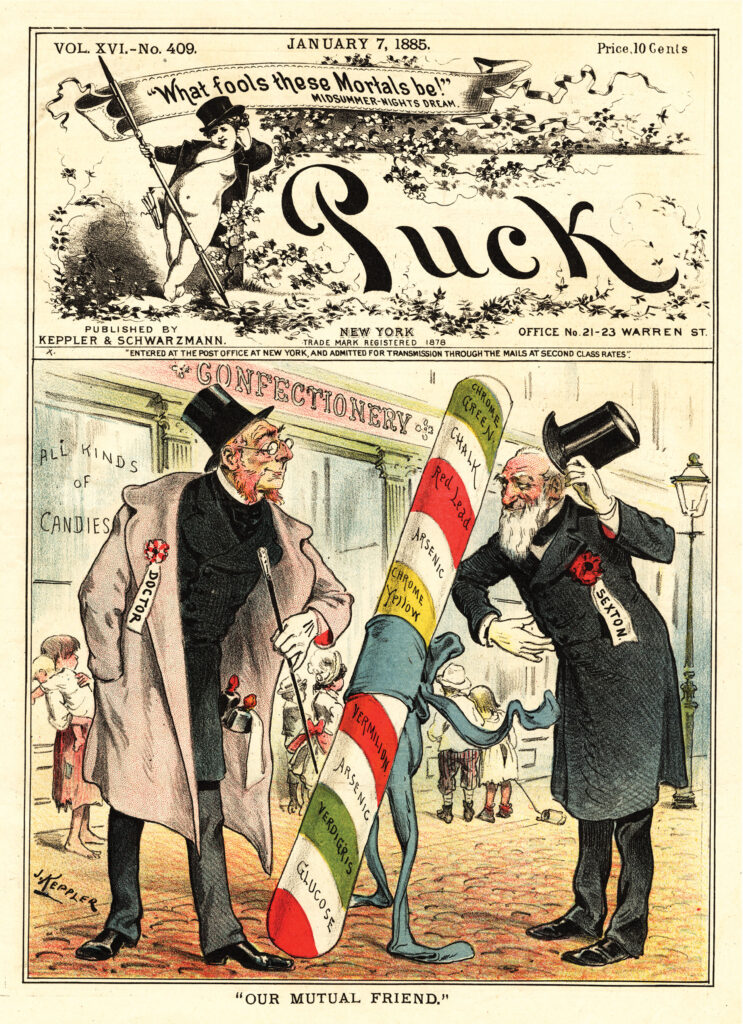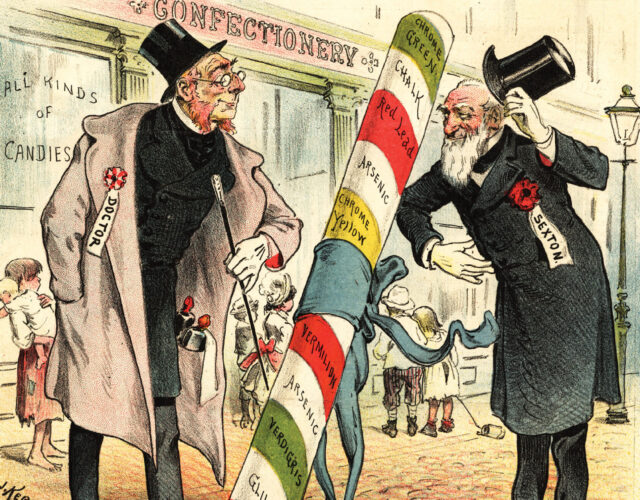We live in a world of bright colors. We’ve gone far beyond the age-old brilliance of sunsets, rainbows, and fresh flowers—to the uncanny blue of sports drinks, the neon green of the latest basketball shoes, and vivid, multihued holiday candy canes. It wasn’t always so. Until well into the 19th century the human world of clothing, food, and shelter was universally drab, all in shades of dirty browns and greys. Brilliant colors were rare, costly, and limited to the very rich. Imagine, then, how enticing a candy of marvelous hues in a window shop must have been to a Victorian-era child? Or how tempting it was for candy makers to use mineral additives to create these intense and unusual colors? Even better, the metallic compounds worked well in tiny amounts, making them cost-effective.
The press took note of this vivid change. This Puck cover appeared on American newsstands in the first weeks of 1885. Two dignified professionals—a physician and an undertaker—each offer an arm to a beribboned candy stick in multicolored attire. At first glance the illustration appears upbeat and cute, but that impression quickly falls away to reveal a sardonic, if sugar-coated, vision created by artist Joseph Keppler. Sadly, the two men regard the candy as a “friend” because its coloring agents cause illness and death and so bring prosperity to each of them.

Our print is an example of just one skirmish in a long campaign of research, regulations, legislative debates, public agitation, media coverage, and court cases that began with Friedrich Accum’s publication in the 1820s of A Treatise on Adulterations of Food and Culinary Poisons. In this long war of words and images on behalf of safe food, Keppler’s acidic satire is one of the most striking graphic interventions and makes visible a truly macabre failure of public health.
Food safety became an issue as cities grew and increasing numbers of people no longer harvested their own crops or preserved their own foods. They became dependent on marketers and manufacturers, whose profit motive tempted some to use cheaper (and often inferior) ingredients along with compounds to mask spoilage or dilution. Chemists and physicians regularly documented the problem of additives—both the relatively harmless adulterants or fillers and the poisonous ingredients. Yet safe levels for lead and other metals in food had yet to be determined, and so to some the risks seemed negligible.
In the early 1880s, just before this cartoon was published, a new wave of concern in Connecticut, Massachusetts, and New York led to anti- adulteration laws for food, paper goods, and fabrics. Strong opposition from commercial interests undercut the laws and inhibited enforcement, and what enforcement there was tended to focus on meat, milk, and bread rather than candy. So it was a notable event when in 1884 the New York City Board of Health destroyed more than 72,000 pounds of adulterated confectionery. The resulting publicity might have prompted this cartoon.
The artist did his homework. Each of the candy stick’s colored bands carries the name of an adulterant or food dye that matches its color in the lithograph. At the top is a green band for chrome green (chromium oxide), next a white one for chalk, then red for red lead (lead oxide). Below are white for arsenic (arsenic trioxide), yellow for chrome yellow (lead chromate), red for vermilion (mercury sulfide), white for arsenic again, then green for verdigris (copper acetate). At the bottom is a white band for glucose (used as an adulterant for sugar and sometimes containing acidic residue from its manufacturing process). All these ingredients were unregulated and readily accessible in apothecary shops and pigment stores and from wholesale sources.
The 19th century saw explosive growth in the number of chemists and in chemical knowledge, including improved understanding of metallic elements and the dangerous dyes made from their compounds. But in a country of small-government ideology and laissez-faire attitudes in commerce, little was accomplished to protect the public despite agitation by journalists, cartoonists, physicians, and scientists. Around the turn of the century the Progressive movement’s muckraking investigations included larger and more frequent exposures of defective food products. Upton Sinclair’s 1906 book about the meatpacking industry, The Jungle, is the most prominent example of many calls to arms. Just months after his book was published, Congress passed the nation’s first Pure Food and Drug Act, which closed one era of food safety advocacy and opened another.




